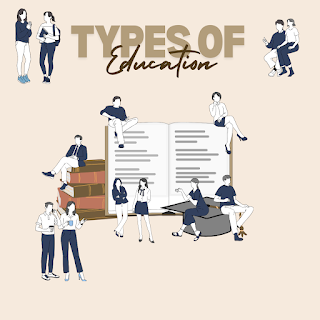Types of Education
Get Informed
November 02, 2023
Being a flexible and unsteady process, education is known to come in countless forms to address countless needs and objectives. Education can further be categorized in terms of the type, ranging from formal education such as certificates, degrees, and diplomas to vocation training, the mode, which could be online learning, and the environment, which is the classroom learning environment. In this blog, we are going to explore the broad spectrum of educational opportunities available today with an emphasis on what sets each of them apart.
The basic framework of our learning process is schooling. Starting with basic education, which takes learners aged 6 to 12 years, there follows secondary education, which takes learners in the age bracket of 13 to 18 years. These phases provide the rudimentary concepts as well as skills concerning the humanities, sciences, languages, and mathematics. Ascending through various trained courses, students are awarded certificates or diplomas.
Offering some degrees (bachelor’s, master's, and doctorate), higher education takes place in college and university and is diverse. It provides specialized knowledge and often lays stress on problem-solving and reasoning. There are specialized opportunities that one is likely to get through higher education depending on the program of study chosen, and individual growth is also fostered.
Vocational education is trade-oriented, preparing students for employment in matters concerning cookery, business, electrical, medicine, and nursing, among others. It also focuses more on the acquisition of information and the application and use of various devices such that when the students are through, they are made ready for the market.
Thanks to the technologies that have emerged, education and courses have been taken and are accessible to students globally. In the current era of social media and the internet, online education delivers the courses and contents in a way that everyone can have access to from any place in the world where an internet connection is available. For those people who are busy and are continuing education throughout their lives, it is a mode of choice because of its flexibility and convenience.
Distance education enables students to learn from home, just as in the case of online education. It was in use before the advent of the internet and often involved the sharing of papers, video and/or audio presentations, lectures, and correspondence. Given the nature of the modern world and the problems of organizing educational institutions for all categories of the population, for individuals who are unable to attend physical institutions, it is a helpful approach.
It entails the provision of extra assistance and facilities to pupils with disabilities. To this end, what makes it a procedure aimed at offering an equal education to all learners is that it aims at attending to the needs of the individual learner.
Adult education courses are designed for those who are out of school-going age or rather are more than school-going age. They offer opportunities to foster various talents, receive certificates or degrees, and find new disciplines. For promotion in their careers or some other reasons, such as personal interest, education is generally sought by adult learners.
An adult-led strategy of early childhood education is known as “mathematics education." It relies heavily on autonomy, prior knowledge, and students learning and interacting with one another in a multi-aged group. Montessori schools tend to provide individual practical lessons and all-round training for the child.
Homeschooling is an emergent form of education still under growth where parents or some other close relatives or caretakers assume charge of their children’s education. It allows for a rather free and unique design of the learning process that corresponds to the needs and preferences of each child.
A liberal arts education aims at the students obtaining education from different fields of specialization and thus is a good approach as far as academics are concerned. This area is the humanities, social sciences, scientific and scientific disciplines, and arts. S3 and N3 make evident that such a kind of schooling fosters critical thinking, creativity, as well as a thorough understanding of global reality.
Technical education is concerned with training concerning knowledge and skills essential in specific businesses or professions. The program prepares students in each area to seek employment in fields such as engineering, information technology, healthcare, automotive technology, and so on.
Environmental education is a distinct approach to learning aimed at the protection of the environment and the enhancement of the understanding of environmental issues. Very often it embodies such activities as physical ones, environmental investigations, and the protection of the ecosystem.
Financial literacy aims at offering persons the knowledge and skills required for the effective management of their money. It contains topics on investing and spending.
Intercultural exchange of education means improving and deepening cultural relations between students. It fosters compassion and awareness about the world at the same time as helping a person analyze a wide array of cultural contexts.
Self-directed learning is a learning method that is based on the individual learner and entertains learner autonomy. Such activities as setting personal goals, searching for relevant resources, and managing one’s learning are all encompassed by it. In most cases, the primary sphere of motivation in self-directed learners is curiosity.
Therefore, the process of education is multifaceted and provides numerous challenges and prospects to enhance one’s profession as well as life. Possible educational opportunities can be formal education as well as non-formal education, self-schooling, and homeschooling. One can choose his/her pathways towards gaining knowledge, self-skill, and overall achievement by embracing the diversification of education. Finally, it is, therefore, the ability of education to flexibly adapt to students’s ever-shifting needs and the world that itself evolves.
Popular Posts
Most Recent
3/recent/post-list
Random Posts
3/random/post-list




.png)

0 Comments